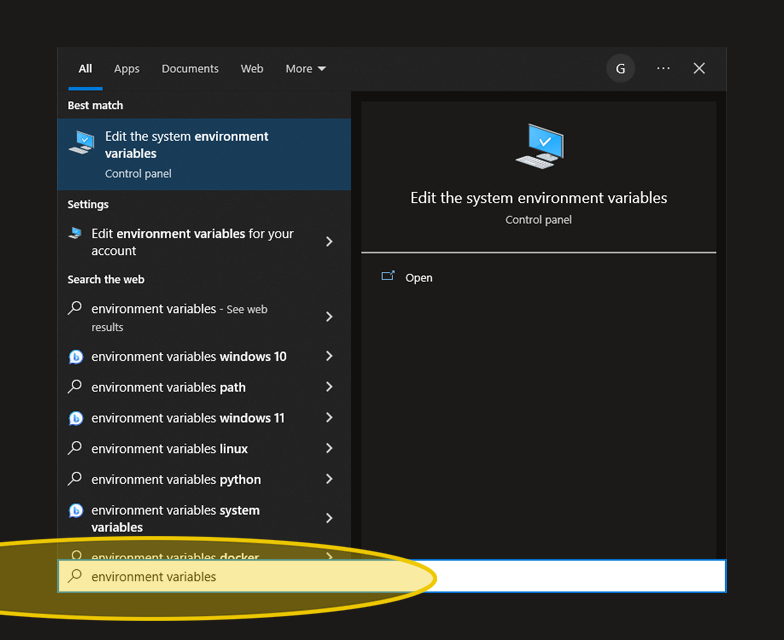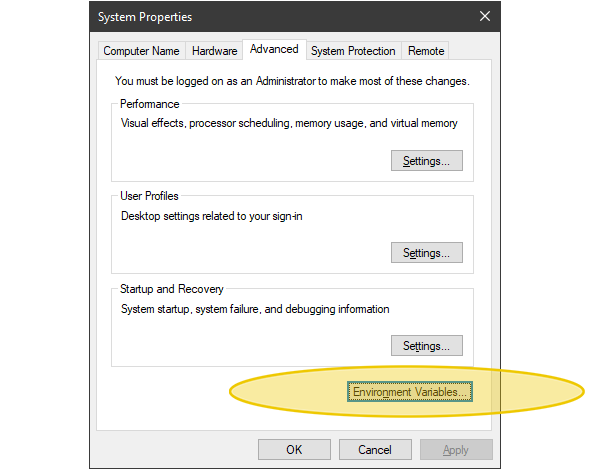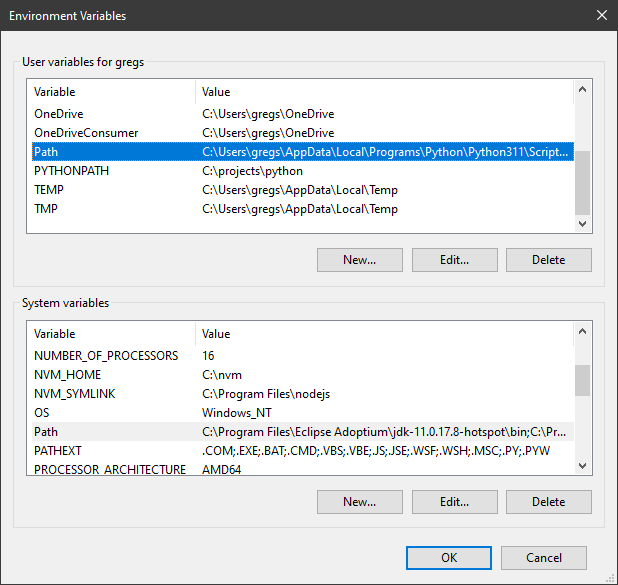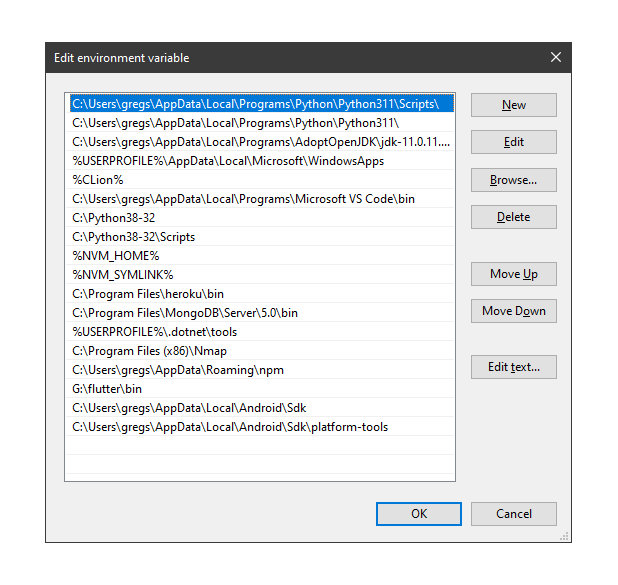How To Add Python To PATH In Environment Variables
Adding python to PATH is something you'll hear and be doing often if you're a web developer. If you're installing Python on your system for the first time, it is essential to add Python to your PATH environment variable on Windows. Instructions are a bit different for Linux. To add python to PATH on Windows follow instructions in this tutorial.
After installing Python, and if Python path is still not added to Environment Variables on Windows platform, the commands python.exe and python3.exe can be executed from command line, but only from directory where Python was installed.
To grant access to other applications like VSCode, for example, you will want to allow the executable files python.exe or python3.exe to be called on the command line from anywhere on your hard drive. This poses security risks, but while developing the project, it's completely acceptable and not entirely unsafe. To do this, you need to add python's insatllation directory to Path variable.
In fact software that requires running python from command line might not be able to find python and produce errors, if it's not added to the system PATH environment variable.
Here's a quick YouTube video on how to add Python to Environment Variables on Windows:
How to add Python to PATH variable in Environment Variables on Windows 10 or 11
Many people search for How to find Environment Variables in Windows 11? or Where are environment variables on Windows? With advent of python-based AI programs, that require adding python to Environment Variables, working with PATH variable has become commonplace.
We will answer there question What does it mean to add python to path? As a step-by-step guide, we will also explain why add python to environment variables.
Time doesn't wait. So let's get started!
How To Add Python To Environment Variables In Windows 7, 10 or 11
To add Python to PATH environment variable, follow these steps:
- Click on Start button from your Windows desktop.
- Type environment variables and press Enter.
- Click "Environment Variables" button on System Properties window.
- Find User Variables listbox where PATH variable will be added for current user.
- Alternatively, use System Variables where PATH variable is systemwide for any logged in user.
- Click on Path variable in any of the two boxes.
- Click "New..." button.
- Type your python installation folder and and press Enter.
- Click "New..." button again.
- Type your python installation folder by /Scripts and and press Enter.
How to find Environment Variables in Windows 10? (it's the same as Windows 11)
Go to your Windows Start button.
Click on Start button once, and simply start typing environment variables
Start typing "environment variables" and press Enter
As you're doing it, this box will show up:

To find Environment Variables on Windows, press Enter.
Doing so will open this other window with your Environment Variables... button:

Clicking on this button will open up another view, where you can add a new environment variable, or edit an existing one. Each variable can have multiple items on it.
In our case, we need to locate and edit Path variable, and then add path to where python was installed to this list.
On System Properties window, click Environment Variables... button.
You don't even need to finish typing environment variables, then just press Enter
There are two main types of Environment Variables: user and system
Now, you can add python to either user variables or system variables
They are both almost the same and will work regardless which box you choose.
But it's still important to know the difference:

Which one should you change?
Locate User Variables list if you want to add python to PATH for current user.
User variables pertain only to the currently logged in user, not entire system.
Locate user variables list, scroll down to where it says Path, and click on it. The Path variable holds a semicolon-separated list of all programs that were added to your system path.
With Path selected, click on Edit... button below.
Locate System Variables list to add python to PATH for system-wide.
If you want to add Python to your entire system, regardless for which Windows is currently logged into the system, use system variables.
Locate system variables list. This one is usually a bit longer. Which makes sense. Because it contains environment variables for entire Windows system.
Scroll down on the list and click Path variable.
With Path selected, click on Edit... button below.
So now, what do we need to add to path variable exactly?
Add C:\python and C:\python\Scripts to Path on Edit screen:
Depending where you installed your python, that's the folder you need to add.
In this example, we will assume python.exe was installed in C:\python folder.
You might also need to add the Scripts folder stemming from installation directory.
In other words: C:\python\Scripts

On this window, press New button.
This will add a new empty entry to PATH environment variable.
This is where you start typing the path to your python installation directory.
In other words, it's the folder where you have your python.exe or python3.exe installed.
In my image above, I have already added C:\Python38-32 and C:\Python38-32\Scripts to PATH. But that's where my Python 3.8 was installed. Because latest Python version is always changing, your folder might be different.
You can add python to either user variables or system variables. Both will work, since you're the currently logged in user. However there is a small difference.
User Variables list (the box on top) will add python to PATH specifically for the currently logged in user. System Variables list (the bottom box) will add pyhton to PATH systemwide, regardless which user is logged in.
How do I know whether to add python to User Variables or System Variables?
For example, if you're installing Python at your school computer (assuming multiple students will log in to use it,) set python path to System Variables. This way you won't have to apply this setting individually for each user.
Generally, if you program alone on your own computer, either option will work. In this case, just set it to System Variables to be sure python will always be available, even if you change your Windows username later.
However, if you have multiple people using your computer, and each logs into their own Windows account, you might want to use User Variables. This way only your user session will have python available on the system, and also it won't interfere with configuration of other unique users on your system.
Articles Related To Python Community
- How to check if your Python interpreter is running in 64-bit mode on 7 Dec 2022 by Ghost Together
- How To Fix ModuleNotFoundError on 3 Aug 2022 by Ghost Together
Last 10 Articles Written On Ghost Together
- New article on 10 Aug 2025
- The dead audience dilemma on 16 Jul 2025 by ディーン・タリサイ
- xv on 24 Jun 2024 by AndrewOcean
- How to get started on 17 Dec 2023 by Kenya
- How To Make Characters In Midjourney on 14 Dec 2023 by Ghost Together
- How to make money online on 12 Dec 2023 by DRSMS313
- How To Make Consistent Characters In Midjourney on 12 Dec 2023 by Ghost Together
- Wildfires and Wastelands on 10 Dec 2023 by A. Stranger
- How To Download, Install And Activate Davinci Resolve Studio 18 on 10 Dec 2023 by Ghost Together
- How to use LUTs in Davinci Resolve 18 on 10 Dec 2023 by Ghost Together
Last 10 Python Questions Asked On Ghost Overflow
- How to Convert a String to a Float in Python? Published date unknown by Ghost Together
- What is the purpose of the yield keyword in Python? Published date unknown by Ghost Together

